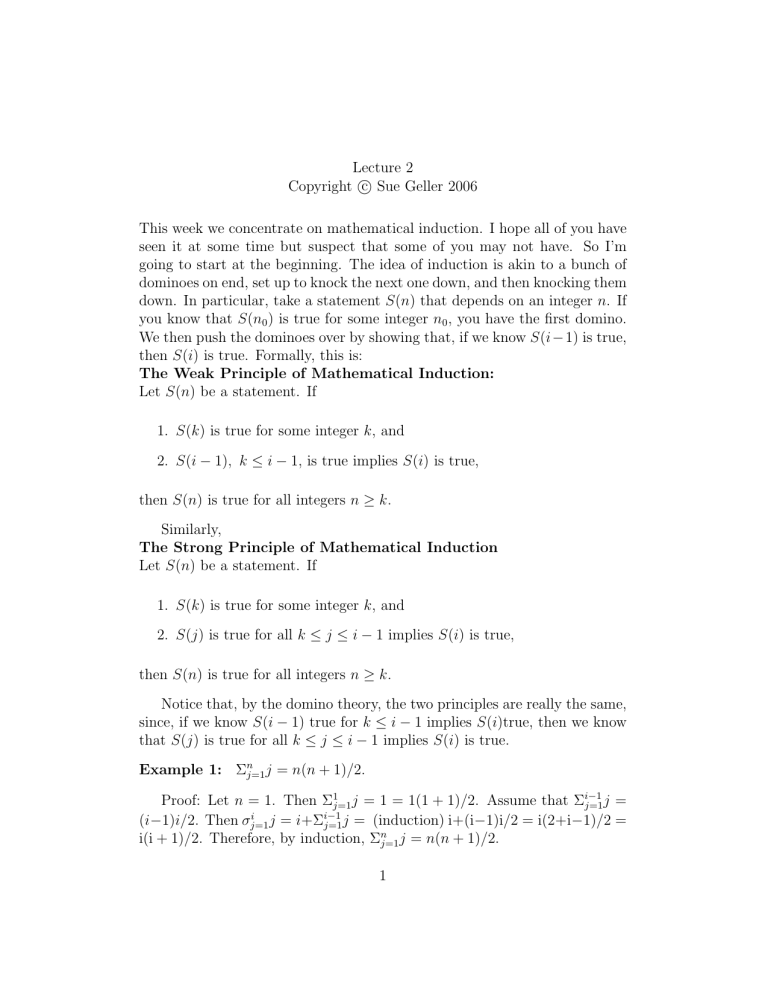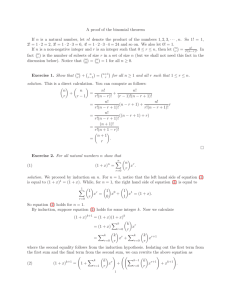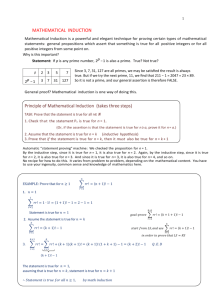Document 10389949
advertisement

Lecture 2 Copyright c Sue Geller 2006 This week we concentrate on mathematical induction. I hope all of you have seen it at some time but suspect that some of you may not have. So I’m going to start at the beginning. The idea of induction is akin to a bunch of dominoes on end, set up to knock the next one down, and then knocking them down. In particular, take a statement S(n) that depends on an integer n. If you know that S(n0 ) is true for some integer n0 , you have the first domino. We then push the dominoes over by showing that, if we know S(i − 1) is true, then S(i) is true. Formally, this is: The Weak Principle of Mathematical Induction: Let S(n) be a statement. If 1. S(k) is true for some integer k, and 2. S(i − 1), k ≤ i − 1, is true implies S(i) is true, then S(n) is true for all integers n ≥ k. Similarly, The Strong Principle of Mathematical Induction Let S(n) be a statement. If 1. S(k) is true for some integer k, and 2. S(j) is true for all k ≤ j ≤ i − 1 implies S(i) is true, then S(n) is true for all integers n ≥ k. Notice that, by the domino theory, the two principles are really the same, since, if we know S(i − 1) true for k ≤ i − 1 implies S(i)true, then we know that S(j) is true for all k ≤ j ≤ i − 1 implies S(i) is true. Example 1: Σnj=1 j = n(n + 1)/2. Proof: Let n = 1. Then Σ1j=1 j = 1 = 1(1 + 1)/2. Assume that Σi−1 j=1 j = i−1 i (i−1)i/2. Then σj=1 j = i+Σj=1 j = (induction) i+(i−1)i/2 = i(2+i−1)/2 = i(i + 1)/2. Therefore, by induction, Σnj=1 j = n(n + 1)/2. 1 Example 2: n2 − n − 20 > 0 for n > 5. Proof: Let n = 6. Then 62 − 6 − 20 = 10 > 0. Assume that (i − 1)2 − (i − 1) − 20 > 0 for 6 ≤ i − 1. Then i2 − i − 20 = i2 − 2i + 1 − i + 1 + 2i − 22 = (i−1)2 −(i−1)+2i−22 > (induction) 20+2i−22 = 2i−2 > 12−2 = 10 > 0 since i > 6. Therefore, by induction, n2 − n − 20 > 0 for n > 5. Example 3: Every integer greater than one has a prime factor. Proof: 2 is prime, so 2 has a prime factor, namely, 2. Assume that j has a prime factor for 2 ≤ j ≤ i − 1. If i is prime, then i has a prime factor, namely, i. If i is composite, then i = ab where 1 < a, b < i. By induction, a has a prime factor, so a = pn for some prime p. Thus i = ab = pnb has a prime factor. By induction, every integer greater than one hasa prime factor. Note: The principal of mathematical induction is basically an assumption. It is equivalent to the positive integers being well-ordered and to the axiom of choice. Well-ordered means that any non-emply subset of the positive integers has a smallest element. The axiom of choice says that I can pick an element out of a non-empty set. These three and others are all equivalent. So you can build you logic by assuming any one and proving the others. Amazing! 2







